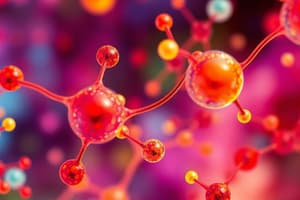Podcast
Questions and Answers
What principle is the Atomic Force Microscope (AFM) based on?
What principle is the Atomic Force Microscope (AFM) based on?
- Centrifugal principle
- Cantilever principle (correct)
- Optical principle
- Electromagnetic principle
What is the diameter of the sharp tip used in AFM?
What is the diameter of the sharp tip used in AFM?
- 5–10 μm
- 50–100 nm
- 1–5 mm
- 10–20 nm (correct)
How is the three-dimensional topographical map of the surface generated in AFM imaging?
How is the three-dimensional topographical map of the surface generated in AFM imaging?
- By plotting the local sample height as a function of the horizontal tip location (correct)
- By using radiation-based microscopy techniques
- By scanning the tip over the surface without feedback mechanisms
- By measuring the force exerted by the tip on the sample
What enables the piezoelectric scanners in AFM to maintain the tip at a constant force or constant height above the sample surface?
What enables the piezoelectric scanners in AFM to maintain the tip at a constant force or constant height above the sample surface?
How does resolution in AFM imaging differ from radiation-based microscopy techniques?
How does resolution in AFM imaging differ from radiation-based microscopy techniques?
What is the most common method used to track deflection in scanning probe microscopes?
What is the most common method used to track deflection in scanning probe microscopes?
What is the purpose of coating the cantilever's back with gold or another metal in an AFM?
What is the purpose of coating the cantilever's back with gold or another metal in an AFM?
What material is typically used to create the probe in scanning probe microscopes?
What material is typically used to create the probe in scanning probe microscopes?
What are some major components of an AFM?
What are some major components of an AFM?
Which type of technique is NOT mentioned for detecting the forces exerted by the sample on the probe?
Which type of technique is NOT mentioned for detecting the forces exerted by the sample on the probe?
Flashcards are hidden until you start studying
Study Notes
Principles of Atomic Force Microscopy (AFM)
- AFM operates on the principle of measuring the interaction forces between a sharp tip and the sample surface at the atomic level.
- The sharp tip typically has a diameter on the order of nanometers, allowing for high-resolution imaging.
Topographical Mapping in AFM
- A three-dimensional topographical map of the sample surface is generated by scanning the tip across the surface and measuring the deflection of the cantilever in response to surface features.
- The map is constructed based on the topography data collected during the scanning process.
Role of Piezoelectric Scanners
- Piezoelectric scanners enable the AFM to precisely control the position of the tip, maintaining either a constant force or a constant height above the sample surface.
Resolution Compared to Other Techniques
- AFM resolution surpasses traditional radiation-based microscopy techniques due to its ability to measure forces at atomic scales rather than relying on light diffraction limits.
Tracking Deflection in Scanning Probe Microscopes
- The most common method for tracking deflection in scanning probe microscopes is using a reflective laser beam that measures changes in the position of the beam reflecting off the cantilever.
Coating of Cantilever
- Coating the back of the cantilever with gold or another metal enhances its reflective properties, improving the detection sensitivity of force measurements in AFM.
Materials for Probes
- Probes in scanning probe microscopes are typically fabricated from silicon or silicon nitride, chosen for their desirable mechanical and chemical properties.
Major Components of an AFM
- Key components include a cantilever with a sharp tip, a laser and photodetector system, a piezoelectric scanner, and a computer for data acquisition and analysis.
Techniques Not Mentioned
- Techniques specifically for detecting the forces exerted by the sample on the probe, other than the commonly used methods, are not included in this context.
Studying That Suits You
Use AI to generate personalized quizzes and flashcards to suit your learning preferences.




